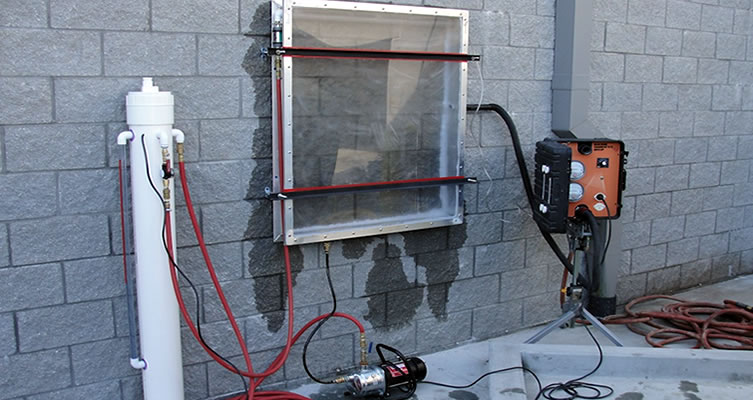The ASTM C 1601 (Standard Test Method for Field Determination of Water Penetration of Masonry Wall Surfaces) covers the field determination of water penetration of masonry wall surface(s) under specific water flow rate and air pressure conditions. Surface penetration is defined as the amount of water that passes through the tested wall surface per unit time per unit area. This is not directly comparable to overall water penetration and leakage, in which the area is defined as the amount of water traveling completely through the masonry system.

The outer wall surface of a masonry wall will experience water penetration when subjected to wind-driven rain. The resistance to water penetration is dependent on materials, workmanship, design, and maintenance. This test is similar to the laboratory version, the ASTM E 514. The ASTM C 1601 determines water penetration of the masonry at its surface. The ASTM E 514 measures the water that has penetrated into and through the masonry system and is collected. Direct comparison of results from this test method and the ASTM C 1601 is not appropriate.
The test chamber is a rectangular chamber with a minimum area of 12SF. The chamber is attached to the wall system using mechanical fasteners and sealant to prevent loss of water and maintain proper air pressure. The chamber has a single line of spray nozzles placed one inch apart. This creates a sheet flow condition during testing. Water is then pumped from the reservoir at a pre-specified flow rate (usually 3.4 gal/sf/h), while pressure is maintained at 10 lbs/sf. Alternate testing conditions may be used based on local climatological data.
The test duration shall be not less than 4 hours after a 30-minute preconditioning period. Preconditioning is designed to adjust water and air flow adequately prior to the actual testing.
During the testing, observations and measurements are recorded.
Initial water flow, air pressure, and water level in reservoir are noted at the beginning.
The technician will:
- Record water flow patterns.
- Record water flow, air pressure, and water level at 5-minute intervals.
- Record the amount and time of which water is added to the reservoir.
- Note all visible lateral and vertical leakage and patterns of leakage.
- Note all interruptions during testing.
- Include all data in the final report document after testing calculations are made to determine water loss.
BDG utilizes professional testing equipment that is calibrated to each specific testing standard for accurate results. Our field consultants are properly trained and knowledgeable of all testing standards. BDG has extensive knowledge of most building systems and specializes in forensic water intrusion investigations. This allows us to not only properly test fenestrations on new construction projects, but also to pinpoint the cause of the failure if there is one and provide accurate recommendations to achieve successful testing results. Failures during quality assurance (new construction) testing can result in unnecessary delays that impact your bottom line.
If you are looking for a reputable second or third-party testing company to perform accurate professional testing, provide concise reports, and help you through the entire process, contact BDG today. We provide testing services throughout the United States from our headquarters located in Atlanta, GA.
Give us a call to discuss your next project.

